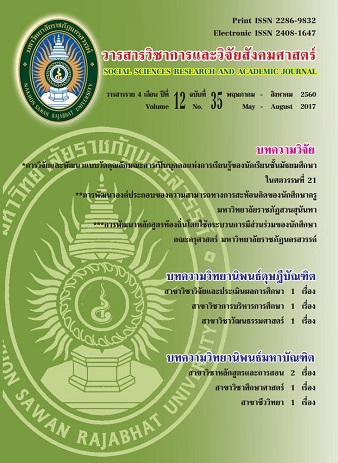การพัฒนาตัวบ่งชี้การบริหารความเสี่ยงเชิงระบบสำหรับโรงเรียน สังกัดคณะกรรมการการศึกษา ขั้นพื้นฐาน; The Development Indicators of Risk Management of Systems for Office of Basic Education Commission
Main Article Content
Abstract
การวิจัยครั้งนี้มีวัตถุประสงค์เพื่อสร้างและพัฒนาตัวบ่งชี้ ทดสอบความสอดคล้องของโมเดลการวิเคราะห์องค์ประกอบเชิงยืนยันกับข้อมูลเชิงประจักษ์ ศึกษาสภาพและแนวทางการบริหารความเสี่ยงเชิงระบบสำหรับโรงเรียนสังกัดสำนักงานคณะกรรมการการศึกษาขั้นพื้นฐาน แบ่งขั้นตอนวิจัยเป็น 4 ขั้นตอนได้แก่ ขั้นตอนที่ 1 เป็นการสร้างกรอบแนวคิดและร่างตัวบ่งชี้ด้วยการศึกษาเอกสาร ทฤษฏีและงานวิจัยที่เกี่ยวข้อง (Content Analysis) ขั้นตอนที่ 2 การพัฒนาตัวบ่งชี้ ด้วยเทคนิควิจัย EDFR (Ethnographic Delphi Futures Research) โดยผู้เชี่ยวชาญ 17 คน ขั้นตอนที่ 3 เป็นการทดสอบความสอดคล้องของโมเดลตัวบ่งชี้การบริหารความเสี่ยงเชิงระบบ กลุ่มตัวอย่างได้แก่โรงเรียนในสังกัดสำนักงานคณะกรรมการการศึกษาขั้นพื้นฐาน จำนวน 400 โรงเรียนโดยผู้บริหารเป็นผู้ให้ข้อมูล เครื่องมือที่ใช้ในการวิจัยเป็นแบบสัมภาษณ์แบบกึ่งโครงสร้าง และแบบสอบถามแบบมาตราส่วนประมาณค่า 5 ระดับ สถิติที่ใช้ได้แก่การวิเคราะห์องค์ประกอบเชิงยืนยัน(Confirmatory Factor Analysis) เพื่อทดสอบความสอดคล้องของโมเดล ขั้นตอนที่ 4 ศึกษาสภาพและแนวทางการบริหารความเสี่ยงเชิงระบบโดยความเห็นของผู้เชี่ยวชาญ 5 คน
ผลการวิจัยปรากฏว่า
- ตัวบ่งชี้การบริหารความเสี่ยงเชิงระบบประกอบด้วย 5 องค์ประกอบ 16 ตัวบ่งชี้ได้แก่ องค์ประกอบด้านปัจจัยนำเข้า 5 ตัวบ่งชี้ ด้านกระบวนการ 5 ตัวบ่งชี้ ด้านผลผลิต 2 ตัวบ่งชี้ ด้านผลกระทบ 2 ตัวบ่งชี้ และด้านสิ่งแวดล้อม 2 ตัวบ่งชี้
- โมเดลในการวิเคราะห์องค์ประกอบเชิงยืนยันอันดับสองมีความสอดคล้องกลมกลืนกับข้อมูลเชิงประจักษ์โดยมีค่า Chi-Square=126.05, df=37, Chi-Square/df = 3.406 , p ≤ 0.05, GFI=0.96, AGFI=0.86, RMSEA=0.078 ,SRMR = 0.031, CFI = 1.00
- สภาพและแนวทางการบริหารความเสี่ยงเชิงระบบมีสภาพการบริหารความเสี่ยงทุกองค์ประกอบอยู่ในระดับสูง กลยุทธ์ที่ใช้ในการบริหารความเสี่ยงได้แก่ กลยุทธ์การลด/ควบคุมความเสี่ยง
Abstract
The purpose of this research was to development indicators; a consistency test of factor analysis model with empirical data, study condition and approaches of risk management of systems for school under office of basic education commission. Research was to four procedure include, The first step had make creation of conceptual framework and form indicators with content analysis of theory and literature .The second had develop indicators with ethnographic delphi futures research technique (EDFR) by 17 experts. The third had a consistency test of model risk management of systems with empirical data. The sampling was amount 400 director school under office of basic education commission. The research instrumental was a five level rating scale questionnaire and semi structure interview form. Statistics had confirmatory factor analysis for a consistency test of model empirical data. The last step was study condition and approaches of risk management of systems by opinions of 5 experts.
The findings of this research were as follows;
- The indicators of risk management of systems had 5 factors 16 indicators including ; factor of input 5 indicators, factor of process 5 indicators, factor of output 2 indicators, factor of impact 2 indicators, factor of environment 2 indicators.
- The second order factor analysis model of risk management of systems had goodness of fit with empirical data (Chi-Square=126.05, df = 37, Chi-Square/df = 3.406, p ≤ 0.05, GFI=0.96, AGFI=0.86, RMSEA=0.078, SRMR = 0.031, CFI = 1.00) .Statistical analysis results confirmed the research hypotheses.
- The study condition risk management of systems for school under office of basic education commission had high level overall with approaches of management by treat strategies.


